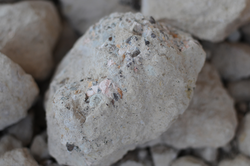Azomite

Azomite

 | This article may have been created or edited in return for undisclosed payments, a violation of Wikipedia's terms of use. It may require cleanup to comply with Wikipedia's content policies. |
Azomite (pronounced ā-zō-mite, officially all-caps AZOMITE) is the registered trademark for a complex silica ore (hydrated sodium calcium aluminosilicate) with an elevated ratio of trace minerals unique to the Utah mineral deposit from which it is mined. When the ash from a volcanic eruption filled a nearby seabed an estimated 30 million years ago, the combination of seawater, fed by hundreds of mineral-rich rivers and the rare earth minerals present in the volcanic ash, created the deposit’s distinctive composition. Mineralogically described as rhyolitic tuff breccia, the geologic characteristic of its surface is referred to as an outcrop known as a hogback. [1]
Scientific analysis
Scientific analysis of this combination of volcanic ash and marine minerals reports over 70 trace minerals, many recognized as essential by the National Research Council of Canada. [2] A typical analysis of an Azomite sample using spark source mass spectrometry reveals the presence of many rare earth elements. [3]
History
Rollin J. Anderson, a geological prospector and organic pioneer, founded Azomite in Salt Lake City, Utah in 1942. Convinced that what ailed America was its food supply and the depleted soil from which it came, he left the city life of San Francisco to pursue development of his father’s Utah-based gypsum mine as a means for neutralizing alkaline farmland, but World War II prevented development. Intrigued by the Native American folklore about the healing powers of the “painted rocks” south of Salt Lake City, Anderson tried to validate their claims.
He brought samples of the pink ore to his friend Charles Head, a scientist at the U.S. Bureau of Mines, whose analysis showed a wide array of minerals similar to the caliche rocks of Chile and Peru, the source for much of the world's nitrate. Head further noted that this was an aluminosilicate mixed with an abundance of minerals, rare in the United States, and even in the world, that appeared to contain "all the essential minerals and trace elements in a balanced ratio and naturally chelated". The analysis showed over 70 trace minerals.
This inspired Anderson to coin the name Azomite for his discovery – an acronym for the A to Z of minerals including trace elements.
Selected by the U.S.
Government to study nitrates in South America (1919-1925), Head had developed a theory that the benefits plants received from nitrates was actually from the minute quantities of trace elements, serving as catalysts. The duo ground the ore into rock dust to see its effects in a controlled environment. Beginning with tomatoes and extending to a wide range of vegetables, they found the Azomite plots produced heartier plants that were also free from the worm infestation prevalent in the non-treated plots.
Expanding their studies to livestock and poultry feed provided results showing improvement in animal growth, reproductive vigor and immunity. Poultry studies showed greater egg production with less breakage. Livestock feed costs lessened with Azomite used as a feed additive, enabling less grain expense. In addition, animals showed a definite preference for pasture grown with Azomite and hay from Azomite treated soils. Based on farmers’ testimonials, Anderson mined, crushed and sold Azomite locally, gaining a following of local farmers.
Upon his retirement in 1988 Anderson leased the reserves to mineral mining company Peak Minerals, led by Wes Emerson.
Emerson continued scientific studies to support the efficacy of Azomite.
In 2011, the Anderson Company’s ownership merged with what is now known as Azomite Mineral Products, Inc. under the direction of.
Emerson as President.
Azomite’s distribution channels now serve approximately thirty countries, with over thirty percent of the company’s sales from international export.
Use
Azomite is used primarily as a natural feed anticaking agent and remineralizer for depleted soils. [1] Hydrated Sodium Calcium Aluminosilicate (HSCAS), its primary component, is listed in the U.S. Code of Federal Regulations (21 CFR 582.2729) as an anticaking agent for livestock feed and is generally recognized as safe (GRAS) by the U.S. Food and Drug Administration (FDA). Agriculture and livestock producers have used Azomite to support livestock health and plant nutrition for over seventy years. While it contains minute quantities of naturally occurring contaminants, Azomite falls well within the guidelines for use in animal feed by the Association of American Feed Control Officials.
As a natural substance, Azomite is listed by the Organic Materials Review Institute (OMRI) for use in organic farming. [13]
Azomite is not approved by the FDA for human consumption.